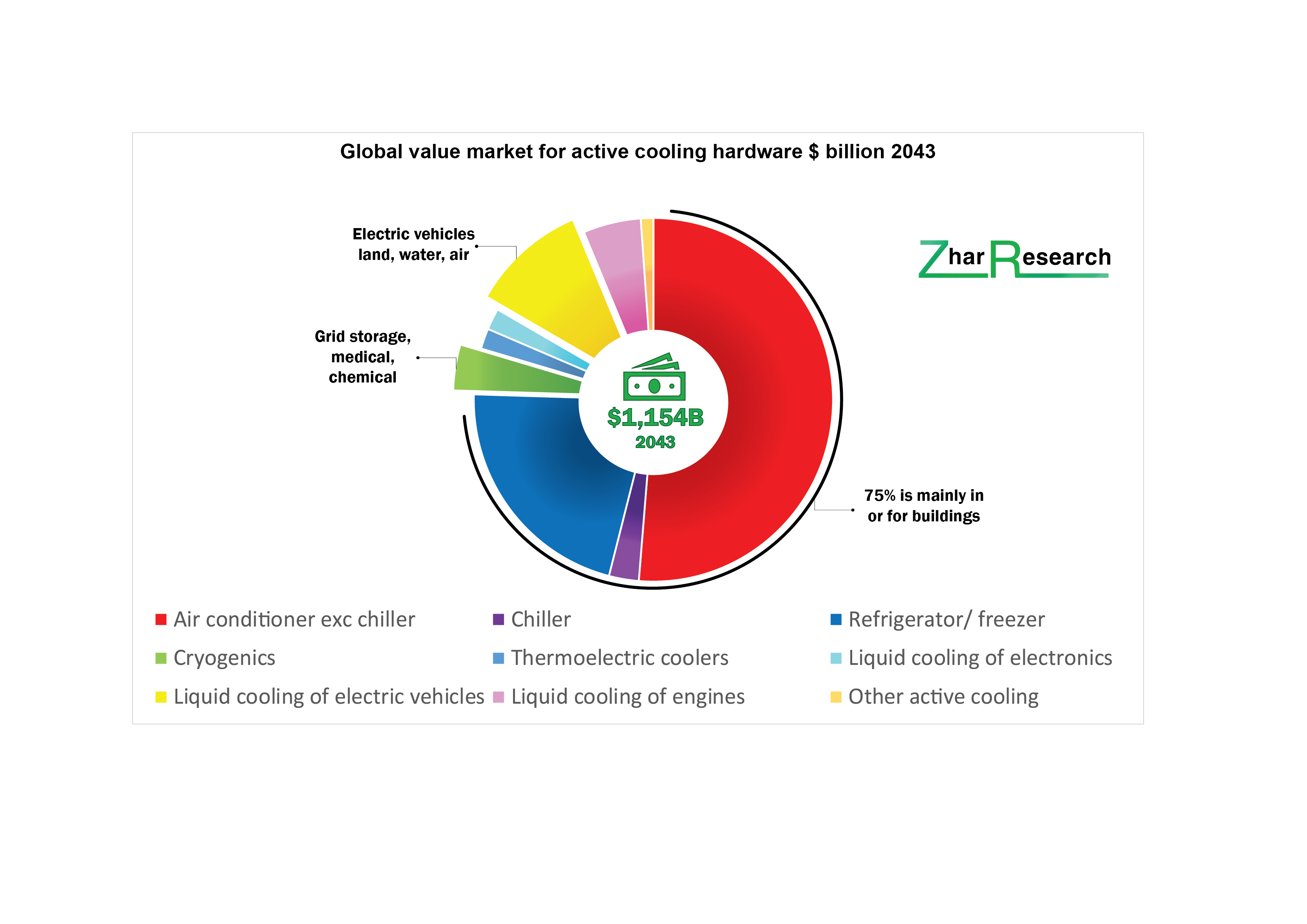Here Comes the Trillion-Dollar Active Cooling Market
It is a no-brainer that global warming already upon us and it creates massive markets for active (powered) cooling. But there is even more ahead, including many new forms of battery, medical, microchip and other active cooling. It is all scoped in the new 285-page Zhar Research report “Active Cooling: Large New Materials, Systems Markets 2023-2043” with 98 new infograms, tables and images, 28 forecasts 2023-2043 and six SWOT appraisals. Because the pace is increasing, a high proportion of the inputs for this report come from 2023
Creating new markets for active cooling, the authors anticipate future higher-power, more-compact data centers, planned massive base stations for 6G communication, large cryogenic air facilities for delayed electricity and much else. Predicted one kilowatt processor chips will demand precision active cooling and there is even active cooling arriving in smartphones.
New cooling challenges include more people living in deserts as population rises and desertification increases. Emerging countries are mostly tropical. They demand far more refrigerators, freezers and air conditioning. The now-rapid adoption of electric vehicles land, water and air demands climate control and sophisticated active cooling of battery, motors and power electronics.
Another megatrend is the move to renewable energy - mostly solar and wind - with chronic intermittency compensated by TWh levels of energy storage, increasingly 6 hours to seasonal Long Duration Energy Storage LDES. Here options with potentially much lower Levelised Cost of Storage LCOS than batteries become important. They include compressed air, liquid air and maybe hydrogen for electricity-to-electricity storage. Together with the giant energy storage batteries for grids, they all need a great deal of cooling. Indeed, for the lowest temperatures, cryogenics demand increases for liquid air LDES, the hydrogen economy, MRI scanners, skin cancer treatments and many other emerging medical applications. It will also enable more superconductivity in engineering.
Wherever you look, new, large markets for active cooling materials and systems are arriving. The largest expenditure will be on the strongest forms such as direct liquid cooling of structural batteries in those electric vehicles but also data centers.
The incumbent vapor-compression and piped-liquid cooling continue to involve global warming, flammability, leakage, size, cost, location and toxicity issues though to a declining extent. In particular, improved refrigerants are rapidly being adopted. However, in taking the necessary twenty year view, the report reveals that breakthroughs such as solid-state cooling will create many billion-dollar companies in an active market that will exceed one trillion dollars within twenty years. That is even after forecasting a global recession crimping initial sales growth. Solid state active cooling arrivals will include electrocaloric cooling and thermoelectrics reinvented, both closely analysed.
Making pumped immersion cooling a mainstream success is another huge opportunity, given that the newer needs are often poorly met by currently-popular technologies. Meanwhile, vapor-compression serves around 75% of value market despite considerable shortcomings. Its use rises with the air conditioner, chiller, freezer and refrigerator markets.
Dr Peter Harrop, CEO of Zhar Research advises,
“Many of the gaps in the market are rather nuanced. For example, a high proportion of formulations in the research pipeline involve toxic precursors and, during wrongful disposal or leakage, toxic by-products. For example, most of the electrocaloric materials researched involve lead or fluoropolymers. Other forms of caloric cooling and proposed electrochemical cooling rarely have that problem. We need more emphasis on solid state cooling and cleaner materials. In particular, the rapid adoption of refrigerants of lower global warming potential GWP needs to be matched by being non-flammable not just less flammable. On the other hand, ethylene carbonate could actually be carbon-negative because you produce it by using carbon dioxide as an input.”
He sees wrong research emphasis with thermoelectrics noting,
“Thermoelectrics are being reinvented but most researchers seek to optimise the figure of merit. Sadly that can lead to the opposite of the required low-cost, high-power (rather than high power density), green systems that much of the market so desperately needs.”
He adds,
“Beyond that, of the plethora of new active cooling options arriving, from switchable optofluidics to chip immersion cooling, industrialists must identify which will remain little more than party tricks and which will be the basis of billion-dollar new operations. They must invest early in the best ones.”
The image gives a Zhar Research estimation of the active-cooling hardware market in 2043. Thermoelectric coolers are a technology rather than an application but they largely represent cooling of increasingly-popular lasers, scientific instruments and other applications not otherwise represented. Chillers are large scale heat removal units typically involving vapor compression and heat absorption. The image is taken from the comprehensive Zhar Research report “Active Cooling: Large New Materials, Systems Markets 2023-2043.”
Press release distributed by Pressat on behalf of Zhar Research , on Tuesday 21 March, 2023. For more information subscribe and follow https://pressat.co.uk/
LDES Cooling 6g 6g Communications Active Cooling New Materials Emerging Technology Energy Electric Vehicles Long Duration Energy Storage Manufacturing, Engineering & Energy Media & Marketing
Published By

anastasiams@zharresearch.com
https://www.zharresearch.com/
Dr Peter Harrop
peterharrop@zharresearch.com
Visit Newsroom
You just read:
Here Comes the Trillion-Dollar Active Cooling Market
News from this source:


